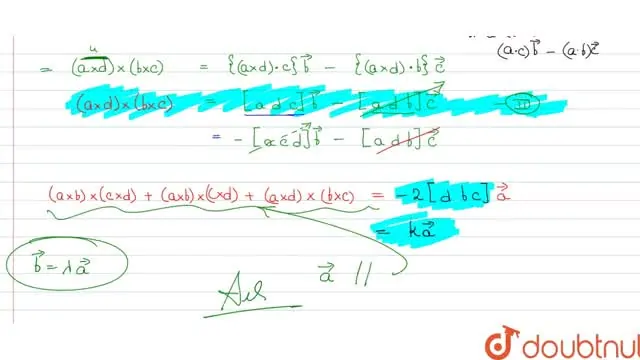If vectors, →b,vcecand→d are not coplanar, the pove that vector (→a×→b)×(→c×→d)+(→a×→c)×(→d×→b)+(→a×→d)×(→b×→c) is parallel to →a.
(→a×→b)×(→c×→d)+(→a×→c)×(→d×→b)+(→a×→dD)×(→b×→c)
Here (→a×→b)×(→c×→d)
−(→c×→d.→b)→a+(→c×→d.→a)→b
=[→a→c→d]→c−[→b→c→d]→a
(→a×→c)×(→d×→b)
=−(→c×→d.→b)→a+(→c×→d.→a)→b
=[→a→d→b]→c−[→c→d→b]→a
(→a×→d)×(→b×→c)
=(→a×→d.→c)→b−(→a×→d.→b)→c
=−[→a→c→d]→b−[→a→d→b]→c
(Note, Here we have tried to write the given expression is such a way that we can get terms involving →a and other simil,ar terms which can get cancelled)
Adding (i), (ii) and (iii), we get
Given vector =−2[→b→c→d]→a=k→a
Hence, given vector is parallel to →a.
Related Playlists
- BOOK - CENGAGECHAPTER - DIFFERENT PRODUCTS OF VECTORS AND THEIR GEOMETRICAL APPLICATIONS EXERCISE - JEE Previous Year (Single Question)28videos
DIFFERENT PRODUCTS OF VECTORS AND THEIR GEOMETRICAL APPLICATIONS
- BOOK - CENGAGECHAPTER - DIFFERENT PRODUCTS OF VECTORS AND THEIR GEOMETRICAL APPLICATIONS EXERCISE - JEE Previous Year (Multiple Question)11videos
DIFFERENT PRODUCTS OF VECTORS AND THEIR GEOMETRICAL APPLICATIONS
- BOOK - CENGAGECHAPTER - DIFFERENT PRODUCTS OF VECTORS AND THEIR GEOMETRICAL APPLICATIONS EXERCISE - Exercise 2.318videos
DIFFERENT PRODUCTS OF VECTORS AND THEIR GEOMETRICAL APPLICATIONS
- BOOK - CENGAGECHAPTER - CONIC SECTIONSEXERCISE - Solved Examples And Exercises1316videos
CONIC SECTIONS
- BOOK - CENGAGECHAPTER - LIMITS AND DERIVATIVESEXERCISE - Solved Examples And Exercises320videos
LIMITS AND DERIVATIVES
Similar Questions
Prove that: (→a×→b)×(→c×→d)+(→a×→c)×(→d×→b)+(→a×→d)×(→b×→c)=2[→b→c→d]→a
View SolutionIf the vectors →a,→b,→c and →d are coplanar vectors, then (→a×→b)×(→c×→d) is equal to
View SolutionIf →a+2→b+3→c=→0 then →a×→b+→b×→c+→c×→a=
View SolutionIf →a,→b,→d,→d be vectors such that
[→a→b→c]=2
and (→a×→b)×(→c×→d)+(→b×→c)×(→c×→d)+(→c×→a)×(→b×→d)=−μ→d
Then the value of μ isView SolutionIf →a is parallel to →b×→c,then(→a×→b).(→a×→c) is equal to
View SolutionGiven that →a,→c,→d are coplanar the value of (→a+→d).{→a×[→b×(→c×→a)]} is:
View Solutionfor any three vectors, →a,→band→c,(→a−→b).(→b−→c)×(→c−→a)=2→a.→b×→c.
View SolutionIf the vectors →a,→b,→c,→d are coplanar show that (→a×→b)×(→c×→d)=→0
View SolutionIf →a,→band→c are three non-coplanar non-zero vectors, then prove that (→a.→a)→b×→c+(→a.→b)→c×→a+(→a.→c)→a×→b=[→b→c→a]→a
View SolutionIf →a,→band→c are three non-coplanar non-zero vectors, then prove that (→a.→a)→b×→c+(→a.→b)→c×→a+(→a.→c)→a×→b=[→b→c→a]→a
View Solution


